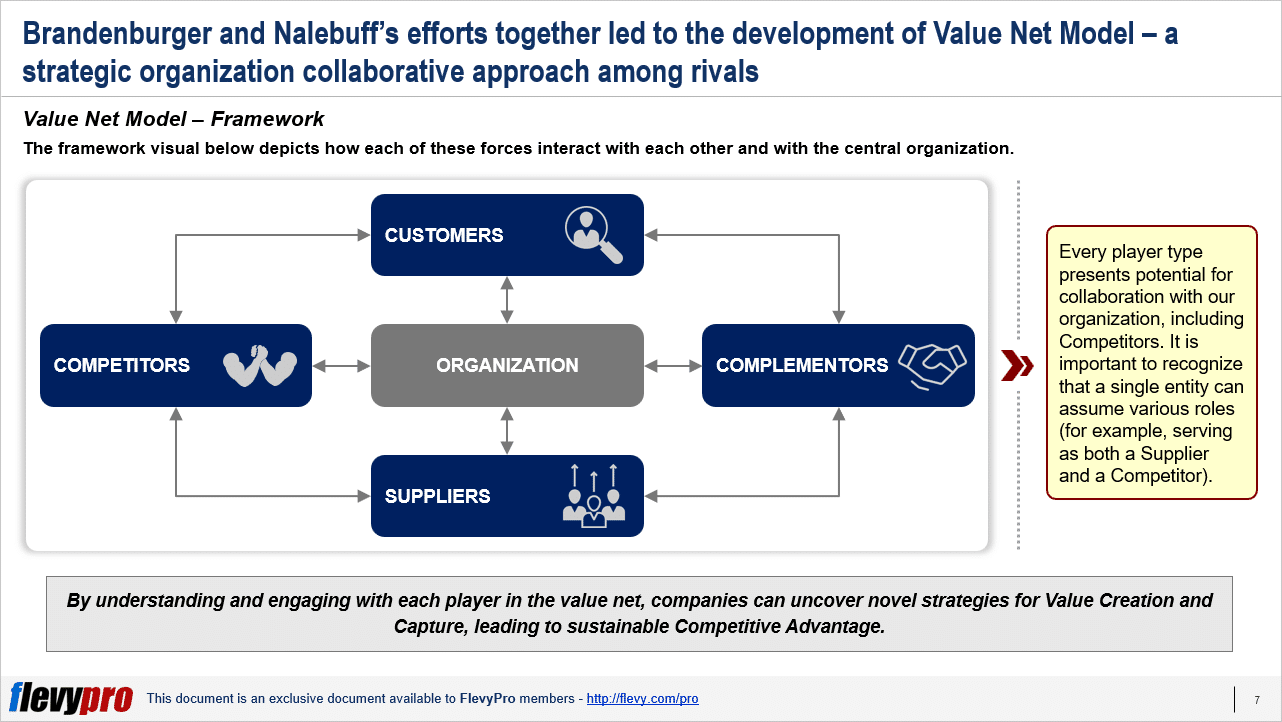Editor's Note: Take a look at our featured best practice, Digital Transformation Strategy (145-slide PowerPoint presentation). Digital Transformation is being embraced by organizations across most industries, as the role of technology shifts from being a business enabler to a business driver. This has only been accelerated by the COVID-19 global pandemic. Thus, to remain competitive and outcompete in today's fast paced, [read more]
Value Net Model
* * * *

The model identifies 4 key types of players:
- Customers
- Suppliers
- Competitors
- Complementors
Each player type holds strategic implications for organizations, influencing their operational and strategic decisions.
The Value Net Model is invaluable as it provides organizations with a more comprehensive view of their competitive landscape. This framework aids in identifying and leveraging both competitive forces and cooperative opportunities, thus fostering innovation and strategic thinking beyond conventional competitive strategies. By recognizing the interconnected nature of these relationships, organizations can develop more robust strategies that account for the dynamic interactions between different players. This not only helps in achieving competitive advantage but also promotes sustainable business practices by integrating cooperation into the competitive strategy.
A deeper dive into the first 2 elements—Customers and Suppliers—reveals their critical roles:
Customers
Customers are the driving force behind an organization’s strategic direction, influencing product development and market positioning. Successful organizations prioritize customer-centricity, utilizing feedback to adapt and innovate swiftly, thus maintaining a competitive edge.
Suppliers
Suppliers, on the other hand, provide essential resources and can significantly impact cost structures and production quality. Effective supplier relationships are foundational to managing costs and enhancing product quality, which in turn supports competitive pricing and market differentiation.
To illustrate the practical application of the Value Net Model, consider these 3 case studies:
- Amazon: By implementing the Value Net Model, Amazon has fostered a collaborative ecosystem, enhancing its relationships with small vendors and third-party sellers, which has driven growth and customer satisfaction.
- Technology Company: A leading technology firm used the Value Net Model to identify synergies with software complementors, leading to bundled offerings that enhanced customer value propositions and drove market expansion.
- Automotive Manufacturer: An automotive manufacturer leveraged the model to better understand its competitive dynamics, leading to strategic partnerships with suppliers of key technologies for electric vehicles, which helped them stay competitive in a rapidly evolving industry.
FAQs on the Value Net Model:
- What are the core benefits of the Value Net Model?
The model helps organizations identify potential cooperative relationships in addition to competitive ones, allowing for a more comprehensive strategy that incorporates both aspects. - How does the Value Net Model differ from traditional models like Porter’s Five Forces?
Unlike traditional models that focus mainly on competition, the Value Net Model also considers cooperation, providing a more holistic view of the business environment. - Can the Value Net Model be applied to any industry?
Yes, its principles are universal and can be adapted to any industry where understanding the interplay between different types of players can benefit strategic positioning and operational efficiency.
The Value Net Model is a robust framework that equips organizations with the tools to navigate both competitive and cooperative landscapes, promoting a strategic approach that can adapt to the complexities of modern markets.
Interested in learning more about the Value Net Model? You can download an editable PowerPoint presentation on the Value Net Model here on the Flevy documents marketplace.
Do You Find Value in This Framework?
You can download in-depth presentations on this and hundreds of similar business frameworks from the FlevyPro Library. FlevyPro is trusted and utilized by 1000s of management consultants and corporate executives.
For even more best practices available on Flevy, have a look at our top 100 lists:

Readers of This Article Are Interested in These Resources

|
|
Excel workbook
|
|
407-slide PowerPoint presentation
| |||
About Mark Bridges
Mark Bridges is a Senior Director of Strategy at Flevy. Flevy is your go-to resource for best practices in business management, covering management topics from Strategic Planning to Operational Excellence to Digital Transformation (view full list here). Learn how the Fortune 100 and global consulting firms do it. Improve the growth and efficiency of your organization by leveraging Flevy's library of best practice methodologies and templates. Prior to Flevy, Mark worked as an Associate at McKinsey & Co. and holds an MBA from the Booth School of Business at the University of Chicago. You can connect with Mark on LinkedIn here.Adam Brandenburger, Barry Nalebuff, Business Ecosystem Collaboration, business model innovation, Business Strategy, business strategy development, Business Strategy Models, Co-opetition, Co-opetition Strategy, competitive analysis, Competitive Analysis Tools, Competitive and Cooperative Strategy, Customer-Centric Strategy, Enhancing Market Position, Game Theory, Game Theory in Business, Organizational Competitive, Organizational Competitive Advantage, Strategic Business Framework, Strategic Business Partnerships, Strategic Decision, Strategic decision making, Strategic Market Players, Supplier Relationship Management, Value, Value Creation in Business, Value Net Model
Top 10 Recommended Documents














